Healdsburg based J Vineyards & Winery has had female leadership since 1986, when Judy Jordan founded the business. J continues to have women in key positions and now spans six estates in Russian River Valley AVA. They’ve featured Nicole Hitchcock’s winemaking talents since 2015 and it’s paid dividends with delicious wines and Wine Enthusiast Magazine’s 2022 Winemaker of the Year award. To expand the discussion surrounding wine in a historically white male industry, J launched “Shifting The Lens,” a guest chef series. Hitchcock collaborated with Jenny Dorsey, Preeti Mistry and Shenarri Freeman on tasting menu pairings and their collaborative Shifted Lens Limited Release Brut Rosé.
J invited me and other media types to preview Freeman’s residency, beginning with a tour and lunch in Eastside Knoll Vineyard and culminating with a full wine pairing dinner in J’s Bubble Room. The experience was eye-opening in terms of what’s possible with vegan cooking, soul food, and wine pairing when people with large platforms consider inclusivity and representation when developing culinary programming. I was happy to hear that “Shifting The Lens” will return in 2023 and hopefully events like these encourage more programs like this around the country and world.
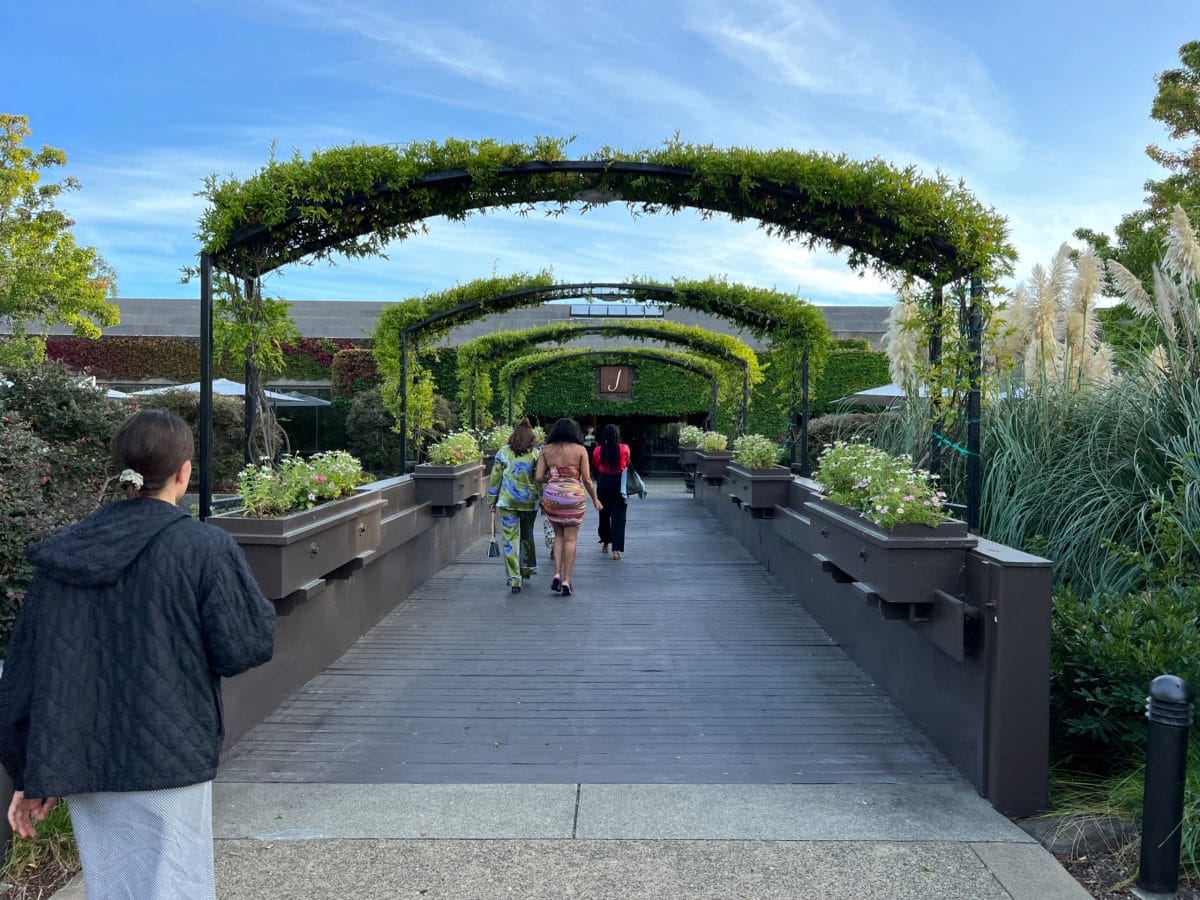
We entered J by planter-lined bridge, crossing a moat containing lily pads and cattails.
Throughout the day, as we shared wine or meals, J team members provided insights into their winemaking process, the “Shifting The Lens” program, and big picture goals. We started in the morning at J Vineyards, sharing a glass of 2012 Brut Late Disgorged Sparkling. Hitchcock and her team were finalizing the fruit press on their harvest’s last day.
Hitchcock explained Judy Jordan’s original vision, saying, “She set out to build a world class sparkling wine house and I think she succeeded.” J has about 30 wines in their portfolio, including Pinot Noir, Pinot Gris and Chardonnay. They exclusively hand harvest fruit at night, since cool temperatures limit extraction. Fruit arrives at 5 or 6 a.m. and they start pressing. She introduced us to their their limited edition, Champagne specific Coquard press from France, explaining, “A hydraulic plate slowly closes in on the grapes and then retracts,” a gentler result that Hitchcock calls a “big advantage.” They pump juice into the winery and age in stainless steel tanks and foudres. J divides batches into “unique, separate entities,” which acts “almost like a spice rack” for blending.
Joyce Chen, Marketing Director for E. & J. Gallo Winery, J’s parent company, rhetorically asked, “How do we honor the future and what the wine industry should look like?” They’ve answered in part with “Shifting The Lens,” a reminder that European men didn’t just develop wine country. Immigrants and women also played, and continue to play, key roles. Chen made it clear, “We can make this industry more inclusive.”
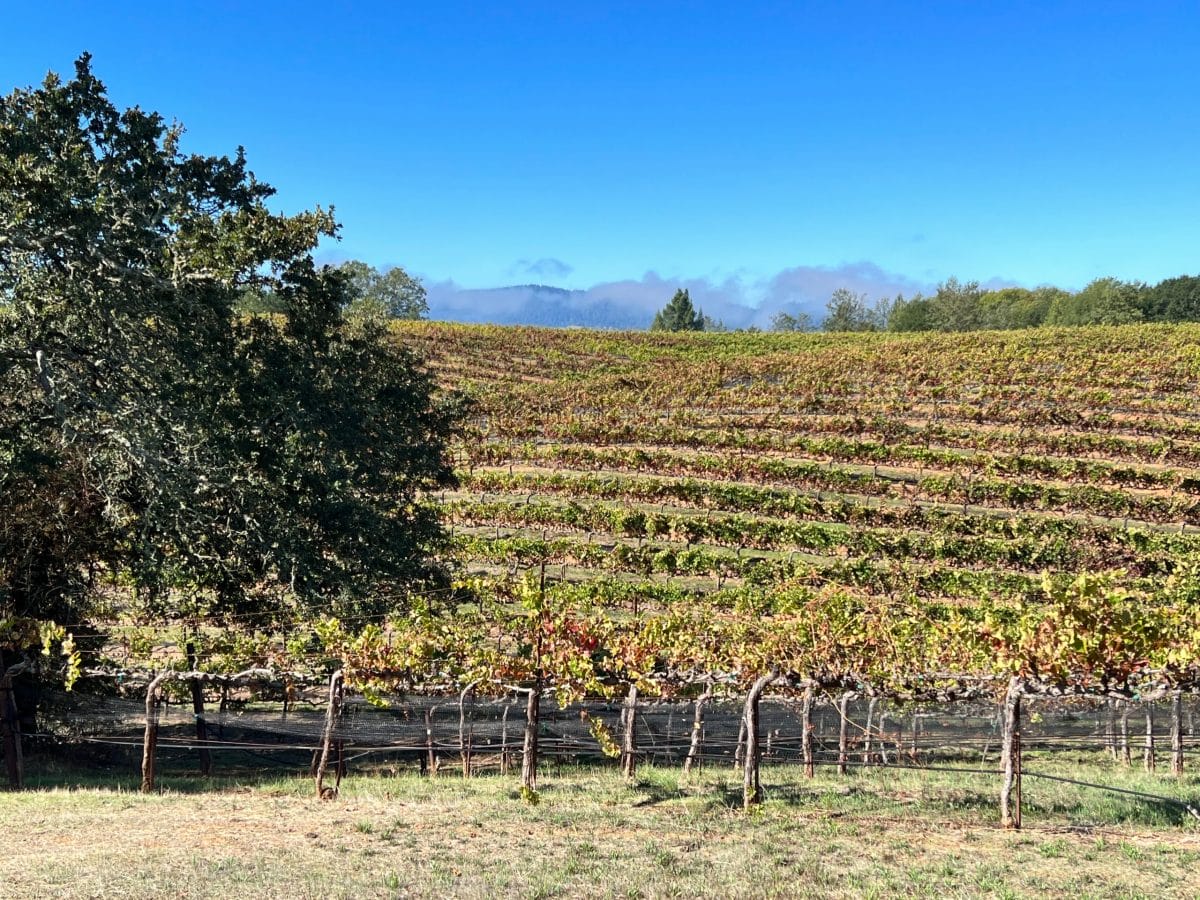
We gathered on a path overlooking Eastside Knoll Vineyard’s rolling Pinot Noir lined hills as the morning fog lifted for the day.
Hitchcock shared Shifted Lens Limited Release Brut Rosé on a scenic hill. J only produced 130 cases, available online in custom gift boxes. “It’s special for a couple reasons,” she said. “This was not just me and my winemaking team looking at different dosage options and selecting something that we thought tasted great. It was truly a collaboration with our chefs. So we sat down in a room, we tasted through a whole bunch of dosage options and wine options, went through a couple different iterations of that and landed on this one in particular. It was fascinating to me to have that dialogue with the chefs because we’re all tastemakers right? We all have a huge focus on sensory and sensory science, but we trust different signs, so coming together, having those conversations and landing on a wine that we thought not only tasted delicious on its own, but would be a great pairing with each and every one of the menus, it was incredible.”
“It’s a blend of Pinot Noir and Chardonnay from all of J’s estate vineyards,” Hitchcock said. “We’ve got six estate vineyards across the region. We’ve got the representation from each one of those sites in this. And this wine actually did not start out as rosé. It started out as a clear fruit style wine, and we made it pink with the addition of the Pinot Noir and Chardonnay and dosage. So kind of shifted it into its current state. So I’m really proud of this. Eight grams per liter dosage, which is firmly kind of in the brut camp. But I love the fruit that this wine puts forth. So much red fruit. There’s some floral and some really interesting toast. Now I can say I’ve had it with all three menus. And it’s a perfect match.”
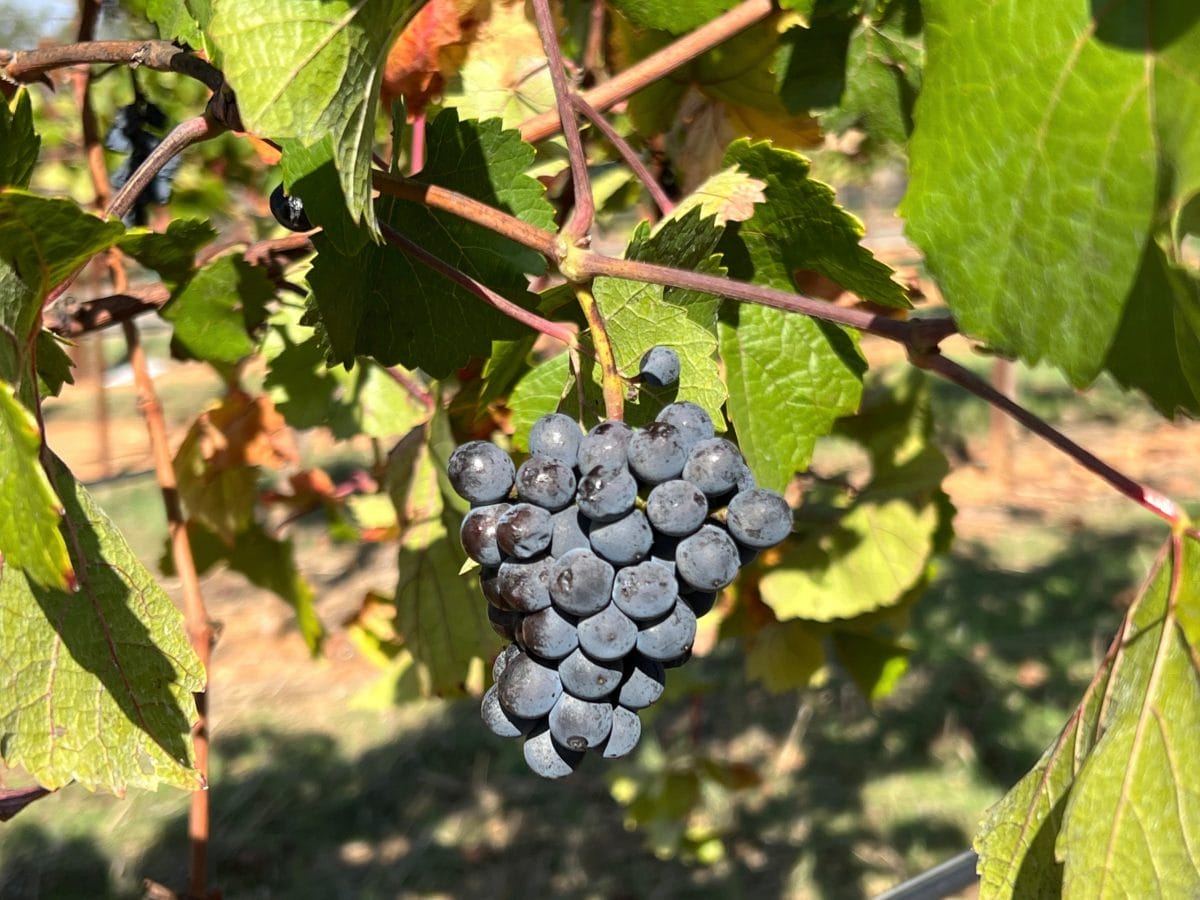
Eastside Knoll exclusively features 40 acres of Pinot Noir plantings. J grows other grape varietals at 5 additional estates.
After exploring Eastside Knoll Vineyard, we enjoyed lunch from Santa Rosa based Spinster Sisters and chef Liza Hinman, complete with singer-guitarist accompaniment. Our family style meal featured dishes like fried chicken, three salads starring local ingredients, Basque cheesecake with figs and balsamic, and an appropriate wine pairing, 2019 Brut Rose made with grapes from the surrounding vineyard.
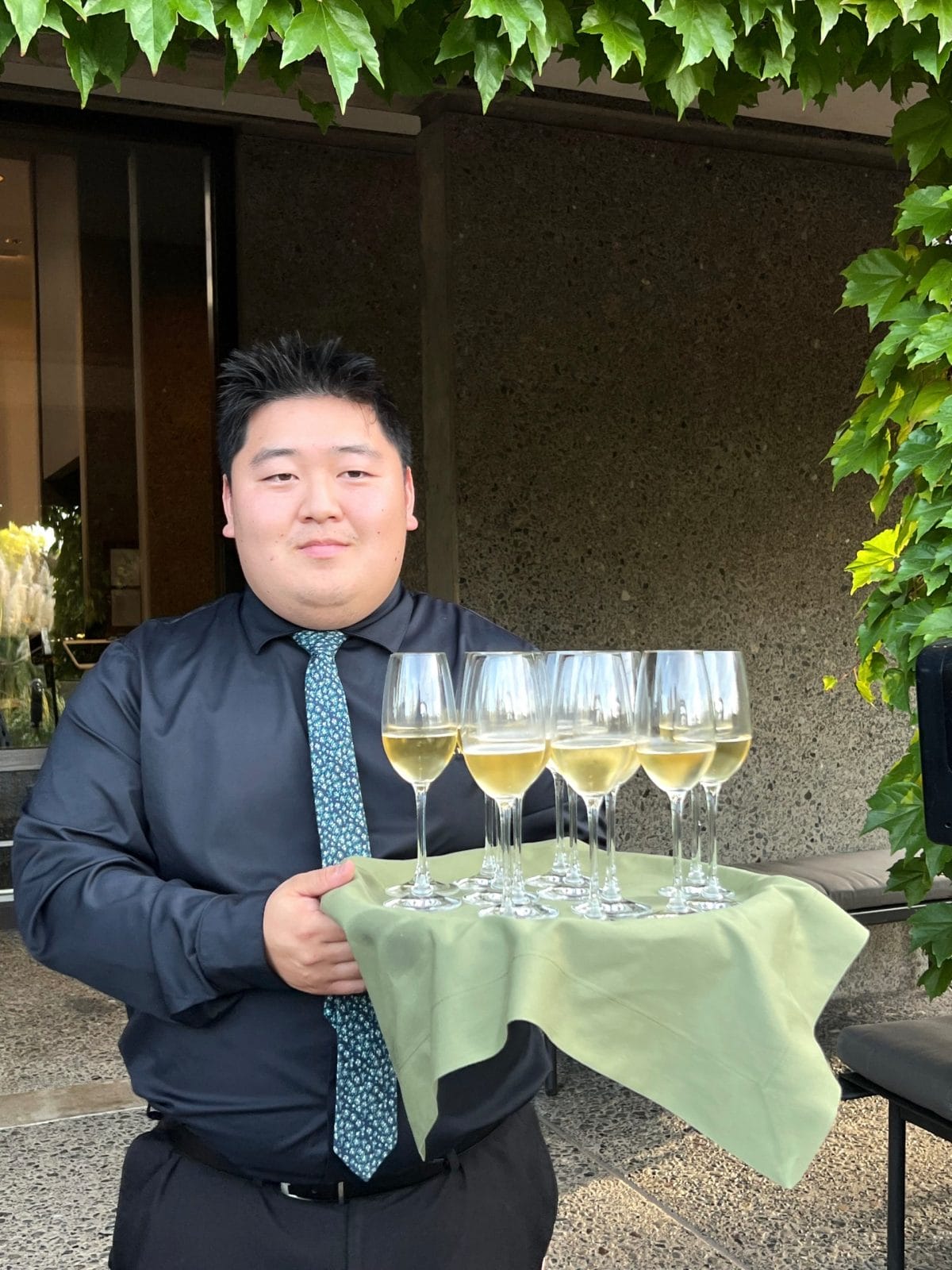
Staffers awaited with glasses of their Cuvée XB upon our return to J’s main facility.
Later that evening, we reconvened on the J Vineyards patio for wine and passed hors d’oeuvres: kale and artichoke dip crostini with fried tomato skin and spiced rice fritters. We met J estate chef Forest Kellogg and executive chef Aaron Meneghelli, who both helped support the “Shifting The Lens” guest chefs. Kellogg said, “It’s so exciting to be involved with something I’m so morally aligned with as well as professionally.”
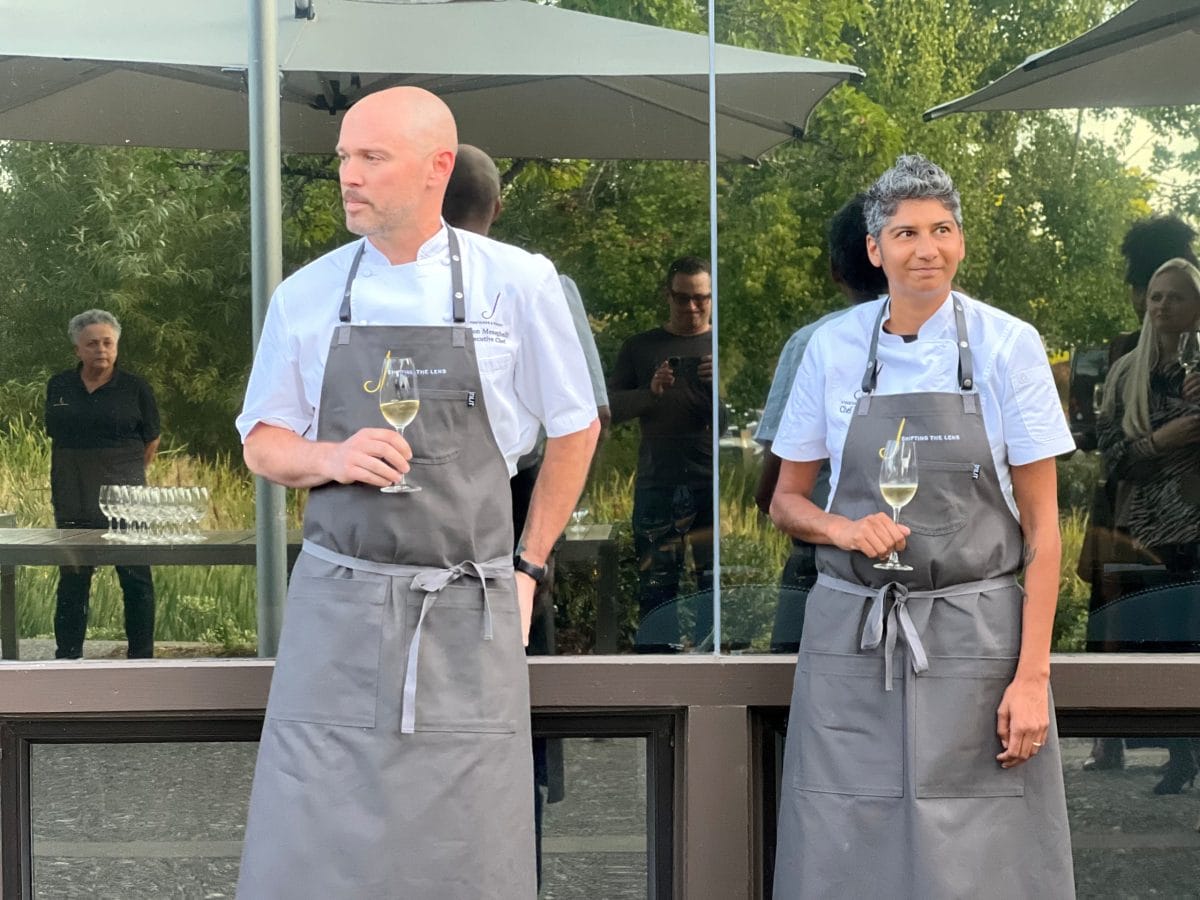
J executive chef Aaron Meneghelli and guest chef Preeti Mistry helped Freeman to execute her menu for “Shifting The Lens.”
Each chef selected a custom tablecloth, place settings, and playlist for their residency in the Bubble Room, providing personal touches to their “Shifting The Lens” dinners. “Green and gold represent health and wealth and prosperity,” Freeman said. “Also being a plant based chef, I think the green was a nice touch. I try to wear green. It’s my favorite color. I’m using green in my cooking… A lot of times when we go to dinners or events, you know, there’s white tablecloths, there’s white chef coats, and everything’s very bright. But I like to kind of switch things up and bring a little bit of my own style. Black tablecloths with gold are a little bit darker, but I think the food is kind of bringing that light.”
Freeman and Hitchcock took turns explaining food and wine pairings. We did get some surprises, starting with cool, herbaceous green gazpacho finished with crunchy lemon cucumber pearls and smoked paprika that left the gift of lingering spice.
BRUT ROSÉ, SHIFTED LENS, RUSSIAN RIVER VALLEY, NV
Collard Greens | Shiitake Mushroom | Espelette | Poached Pears
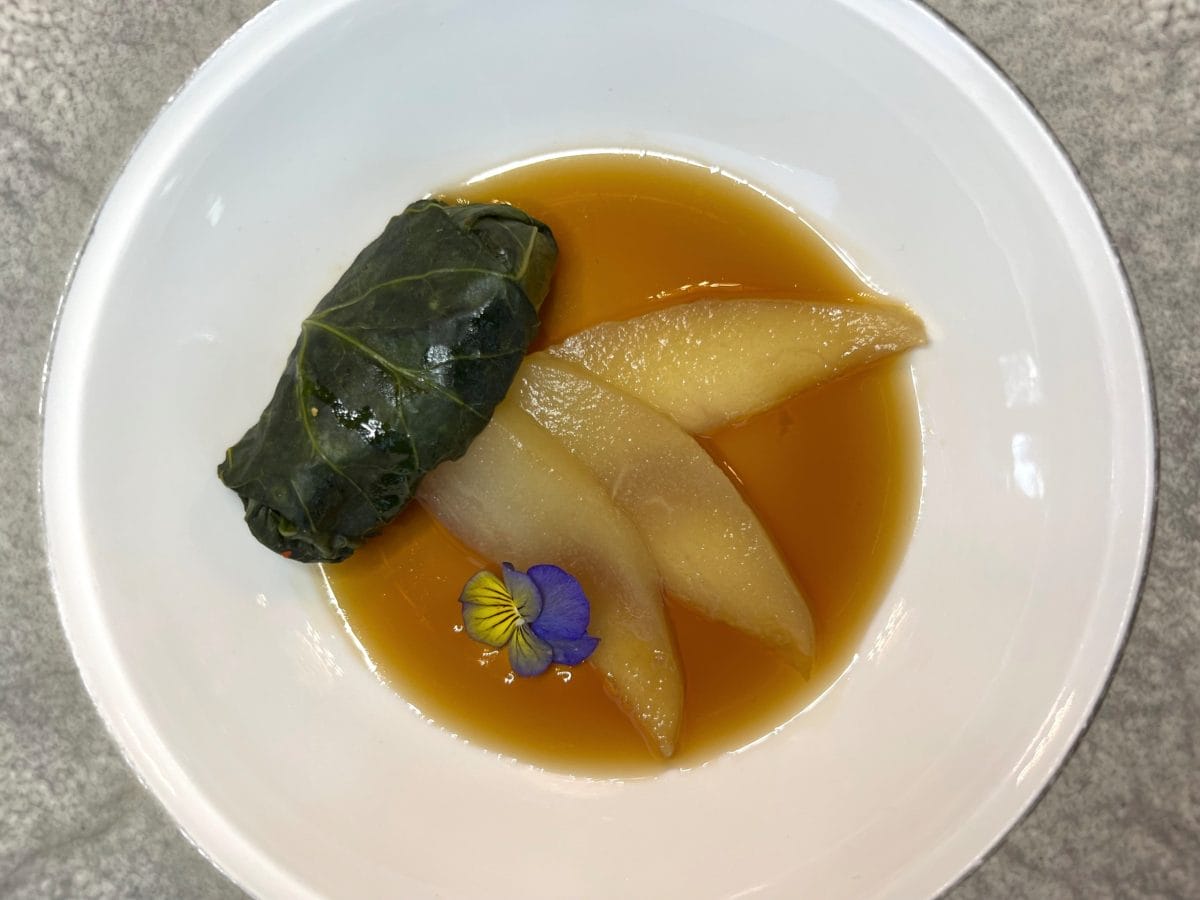
Collard greens cooked in chickpea miso broth and cradled shiitake mushrooms, leeks, yellow peppers, and espelette onions. Freeman poached pears with black cardamon, ginger, cinnamon, apple cider, and J chardonnay. To finish: maple balsamic jus.
PINOT NOIR. EDITION NO. 2. SONOMA COAST. 2017
Trumpet Mushroom | Maple Black Garlic | Roasted Red Pepper Pesto | Pickled Mustard Seed
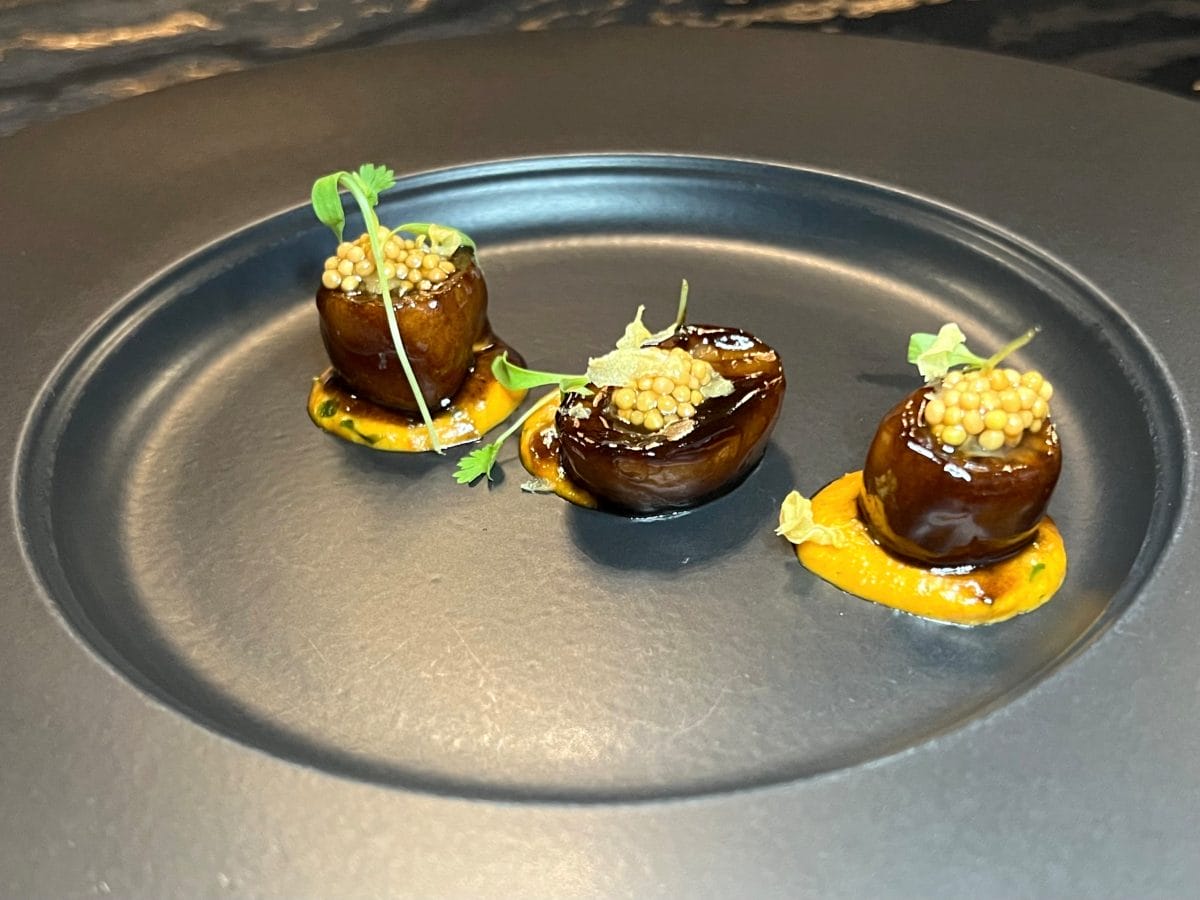
“I’m from Virginia and we love seafood,” Freeman said. “Seafood’s not vegan, so I like to play around a little bit… I cut [trumpet mushrooms] and make them kind of look like scallops… They cook down in a nice maple black garlic sauce. Underneath that we have some roasted red pepper pesto puree. A little bit of crispy garlic up top for some texture followed by some pickled mustard seeds, which we pickled in rosé and chardonnay. Then we placed some cilantro on top since I like to put green stuff in my food.”
PINOT NOIR, CANFIELD, RUSSIAN RIVER VALLEY, 2018
Okra Gumbo | Chickpea Miso | Cajun Seasoning | Basmati Rice
VINTAGE BRUT. RUSSIAN RIVER VALLEY, 2014
Jerk Oyster Mushroom | Farro| Berbere | Pine Nut Ricotta| Pickled Radish
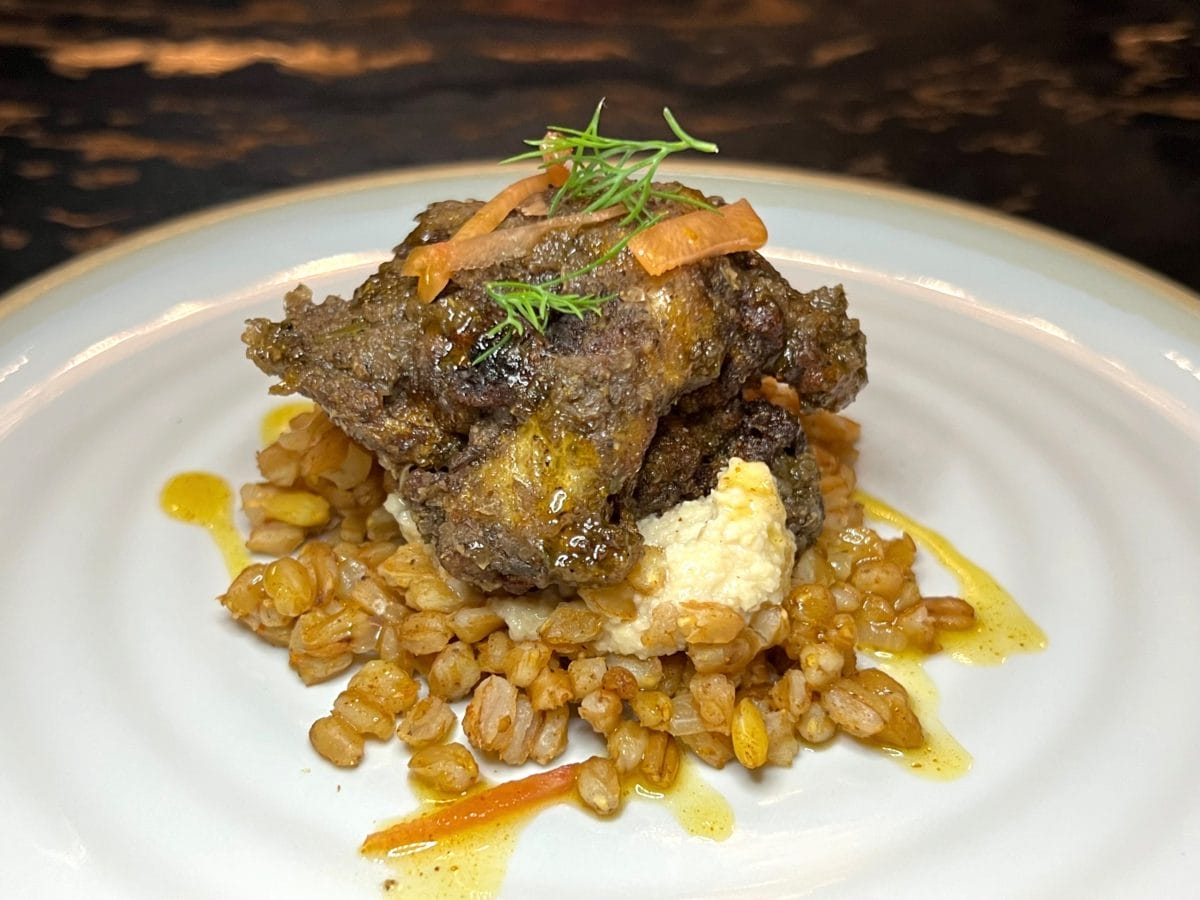
Freeman boosted fried oyster mushrooms with her friend Nick’s jerk seasoning and added Ethiopian berbere spice to farro. “On top, using some local curry balsamic I found at the farmers market. I just thought that was cool,” she added. “We also have some pickled watermelon radish on top. Finished off with a little bit of dill. And we made some pine nut ricotta with some umeboshi plums. So there’s a lot of different flavor, textures. Don’t be afraid of the spice.”
LATE DISGORGED, RUSSIAN RIVER VALLEY, 2013
Plantain Pudding | Turmeric | Coconut Cream | Vanilla Wafer | Caramel
To finish, we received Ube Blondies from The Blondery and Dark Chocolate Truffle from BACI Kitchen (long rectangle). Freeman also gave us zucchini bread muffins for the road baked with maple crystals, flax seeds, and vanilla extract.
During a post-dinner Q&A with Joyce Chen, Nicole Hitchcock and Shenarri Freeman, guests heard powerful personal stories and background on “Shifting The Lens,” which should continue at J Vineyards & Winery beyond 2022.
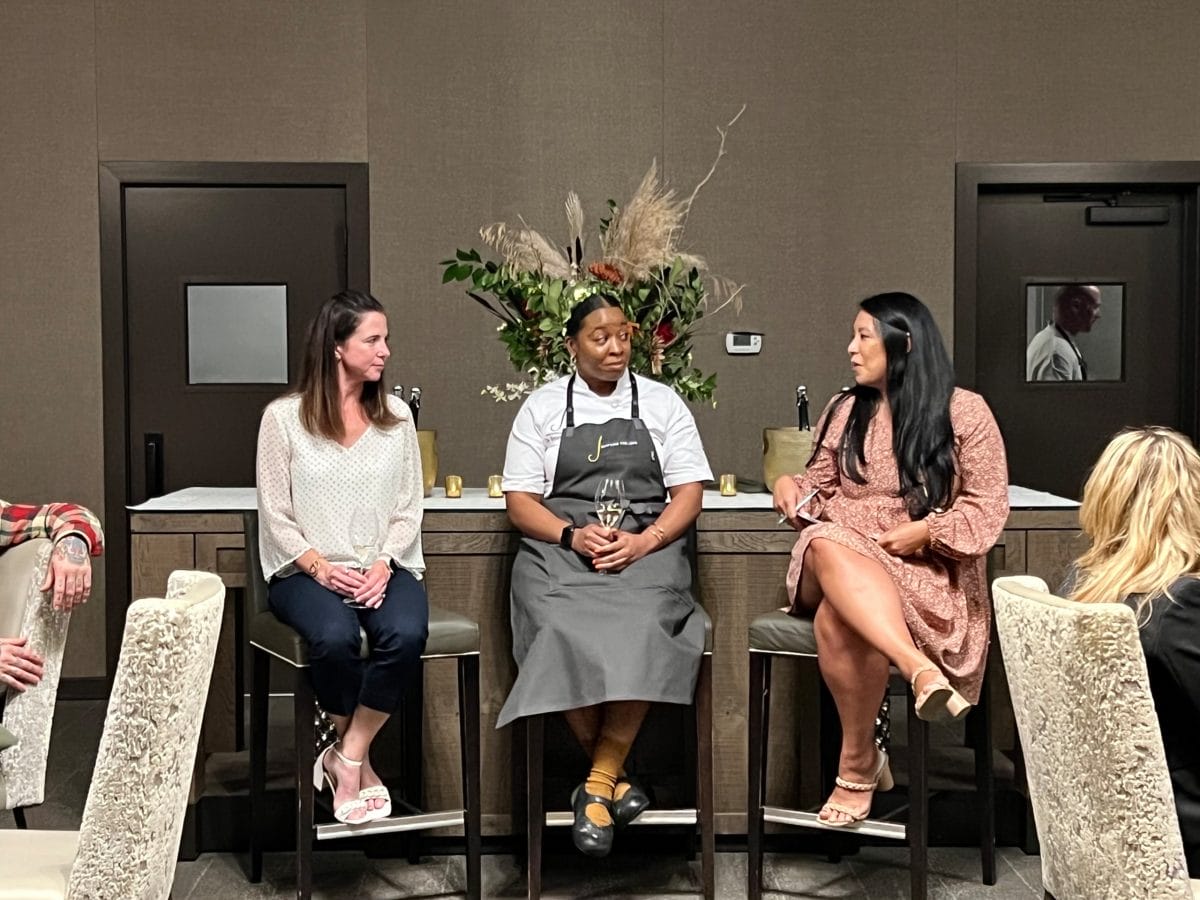
Nicole Hitchcock, Shenarri Freeman and Joyce Chen shared personal connections to food and wine and discussed inclusivity.
Chen recalled her first “Shifting The Lens” talk with Freeman. “How do we expand perspectives? How do we think about traditional food wine in a different way?” She said, “The history of wine country is actually built on diversity. It’s built on so many different types of people, whether it was the Chinese immigrants that helped us plant the first vineyards or dig the first caves, to the people who work in the industry today to help grow the grapes, who help us with harvest, who help us just really truly champion where we are today. And America has changed. Even as I look around this room, it’s really exciting to see just the diversity in this room, not just in culture, but also in thought, in background and perspective.” Time to expand beyond Eurocentric points of view. “We’re so excited to have you at our table,” she said, “especially when we think about food and wine being such a great unifier of bridging cultures and bringing people together.”
Freeman faces similar limitations in food. “Vegan food nowadays is very one-dimensional and seen through a certain lens,” she said. “I wanted to change that. I wanted to cook with actual vegetables and fruits and things that come from the earth. When we talk about cooking with soy or processed foods and things that aren’t natural or lab grown, it kind of defeats the purpose…I go out of my way to source ingredients because I care. I think that’s the message that everyone should care for themselves when you’re cooking at home. Hopefully other chefs are adapting a similar style of cooking.”
Freeman’s menu for “Shifting The Lens” defied expectations. “People reference the restaurant as being soul food or Southern food. They’re just like, ‘Oh, that’s all she cooks.’ I cook a lot of different things…This was a perfect opportunity to dip into some West African dishes that I’ve been practicing and doing recipe development. Dip into some Caribbean dishes that I’ve been practicing as well. I really wanted to showcase that broad spectrum of what I’m capable of doing.”
“I’ve learned so much over the course of this entire series,” Freeman said. “I tasted foods and textures and flavors that I had never experienced before. And I got to taste them with those who were creating them. For me, that expanded not only my knowledge of food and wine pairing and my experiences in that area, but it just broadened my horizons… Anything’s possible when it comes to food. Don’t just kind of go into situations with one mindset. Just be very open.”
“We should all be open to trying different types of pairings with all different types of food,” Hitchcock said. “We all might naturally lean towards having a beer with Thai food, or having some of those for obvious pairings that just seem much more familiar, but there’s so much more you can do with the pairings, especially when you’re looking at wines like sparkling, like Pinot Noir that are so food friendly, and have so much diversity just within that type of wine, that really, there’s no bounds.”
“One thing that I hope that we all take away is that this is a small step and change that’s actually hopefully going to lead to a bigger step,’ Chen said. “For us to be able to see ourselves in this industry, to be inclusive, to show that all cultures belong as part of the wine industry, is something I really, really hope that we all take away.”
Preeti Mistry supported “Shifting The Lens” throughout the series, not just during their residency, and they also spoke post-meal. “Tonight has proven how we all need to expand our minds, our palates, and our expectations and not just create opportunities where we say, ‘This is an opportunity for everyone,’ they said. “We have to be proactive about those opportunities. We have to go out of our way to say this is an opportunity for women of color to be seen because that is expanding our horizons and giving an opportunity – and all of you and the folks that are going to come to the Bubble Room in the next few weeks – an opportunity as well. To taste something and to get something they can’t experience anywhere else…It makes perfect sense, everything you’ve tasted, all the wines, all the food, everything, yet it’s such an anomaly that we are all gathering in this way.”
“What “Shifting the Lens” means to me is taking that extra step,” Mistry said. “If change is the only constant, then standing still is in fact moving backwards.”

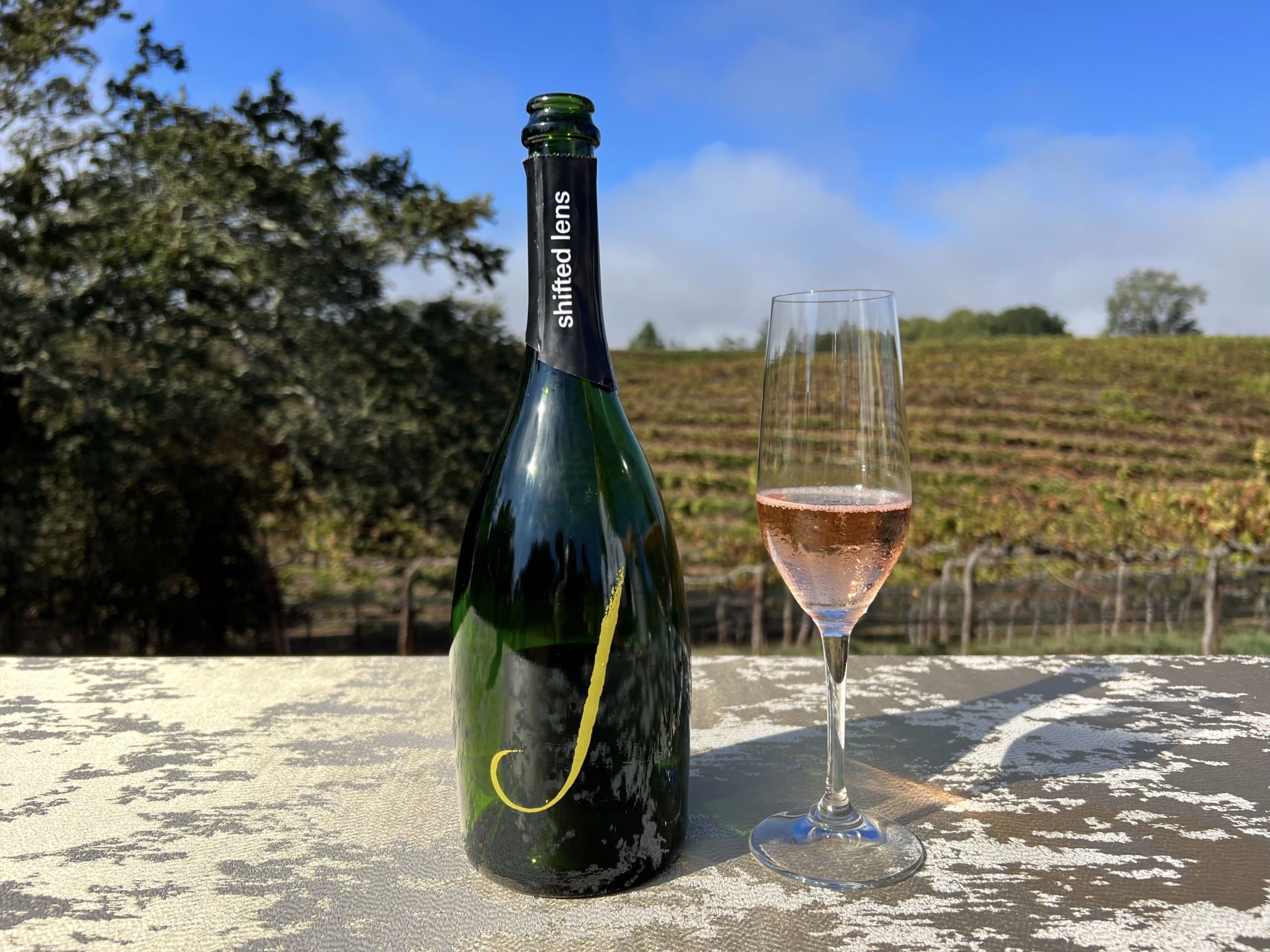

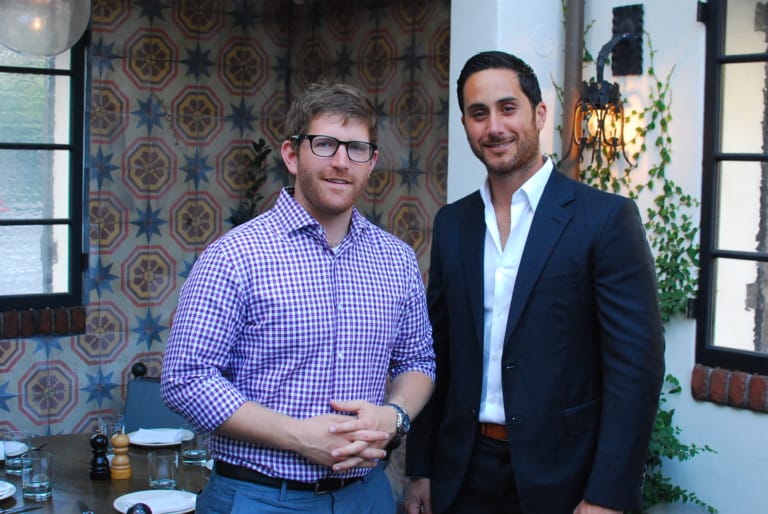
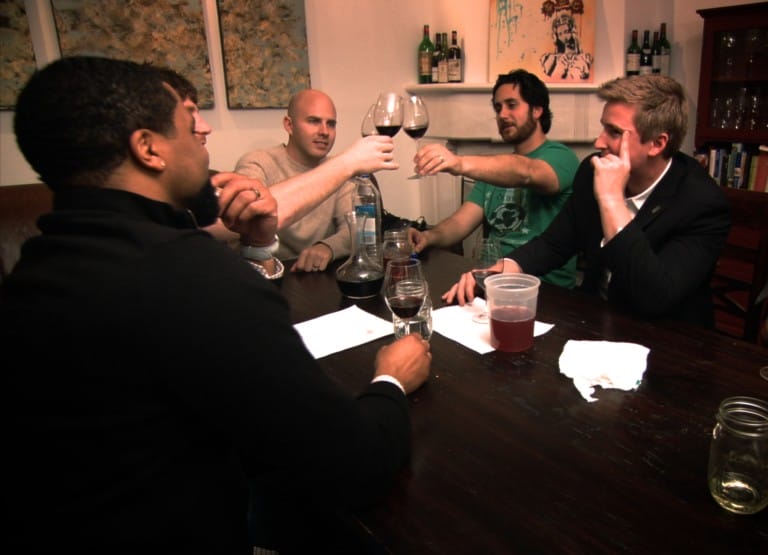




Leave a Comment